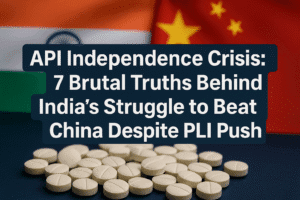API Independence Crisis: 7 Brutal Truths Behind India’s Struggle to Beat China Despite PLI Push
India’s push for pharmaceutical self-reliance faces intense market realities. While the PLI scheme has successfully spurred ₹4,254 crore in domestic API investments and lowered some local production costs, aggressive Chinese price undercutting – with import drops of up to 50% – has stalled significant import reduction. Targeted cuts in critical drugs like antibiotics and cholesterol medications keep Chinese imports cheaper than new Indian output. Industry voices suspect predatory pricing tactics to maintain China’s dominant 70% import share, but view this as unsustainable long-term.
Acknowledging the challenge, the government has initiated a PLI scheme review to bolster domestic viability. This struggle reflects the complex transition toward healthcare sovereignty: building foundational capacity through PLI is progressing, yet overcoming entrenched supply chains demands persistence and adaptable policy beyond initial price wars. The journey remains a marathon, not a sprint.

API Independence Crisis: 7 Brutal Truths Behind India’s Struggle to Beat China Despite PLI Push
India’s ambitious Production-Linked Incentive (PLI) scheme for Active Pharmaceutical Ingredients (APIs) has undeniably ignited domestic manufacturing. With Rs 4,254 crore invested and 34 out of 48 approved projects already operational, the initiative is fostering a crucial homegrown base for these essential drug components, driving down some domestic prices. Yet, as recent market dynamics starkly reveal, declaring victory over import dependence – particularly concerning China – is premature. A fierce price battle is underway, forcing a government review and highlighting the gritty realities of shifting global supply chains.
The PLI Success Story (So Far):
There’s tangible progress. The scheme has demonstrably:
- Catalyzed Investment: Billions of rupees are flowing into new and expanded API manufacturing facilities.
- Lowered Domestic Costs: Increased local production has pressured prices for several Indian-made APIs downward.
- Built Critical Capacity: Covering 25 bulk drugs so far, the scheme is laying the groundwork for future self-sufficiency.
The Chinese Counterpunch: Aggressive Undercutting
However, the anticipated rapid decline in reliance on Chinese imports hasn’t materialized as hoped. Facing new competition, Chinese suppliers have executed a ruthless strategy:
- Drastic Price Cuts: Landed costs for key APIs from China have plummeted by up to 50% year-on-year, significantly outpacing domestic price reductions.
- Examples Tell the Tale:
- Atorvastatin (Cholesterol): Domestic price fell 17% to ~Rs 10,000/kg. Chinese import price crashed 33% to ~Rs 8,000/kg.
- Ofloxacin (Antibiotic): Domestic price down ~16% to ~Rs 2,700/kg. Chinese price slashed ~30% to ~Rs 2,100/kg.
- Targeted Strategy: This aggressive undercutting is most pronounced in critical categories like antibiotics, hypertension drugs, and painkillers – precisely where India seeks independence.
Industry Insights: Predatory Pricing & Temporary Pain?
Industry leaders interpret China’s moves as a deliberate defense of market dominance:
- Below-Cost Suspicions: Many executives, like Bhavin Mukund Mehta (Kilitch Drugs/Pharmexcil), believe China may be exporting below production cost to stifle nascent Indian competition.
- A “Temporary Phenomenon”?: Figures like Jatish Sheth (Confederation of Indian Pharmaceutical Industry) argue this strategy is unsustainable. They contend Chinese players cannot sustain such losses indefinitely, especially as Indian PLI-funded capacities fully ramp up, predicting some Chinese suppliers may eventually exit the Indian market.
The Stakes and the Government’s Response:
The dependency is deep-rooted: China still supplies ~70% of India’s API imports, representing roughly 35% of India’s total API consumption. The PLI scheme, with its Rs 6,940 crore outlay running until FY29, was designed precisely to break this stranglehold and bolster healthcare security.
Recognizing the price-undercutting challenge, the government has initiated a review of the PLI scheme. The Department of Pharmaceuticals is actively soliciting industry input on potential modifications to better counter Chinese tactics and accelerate true self-reliance.
The Road Ahead: Persistence Over Premature Declarations
Labeling India’s efforts a “losing battle” is an oversimplification. The situation is more nuanced:
- PLI is Building Foundational Capacity: The investments and plants coming online are real and necessary. This infrastructure is crucial for the long term.
- China is Fighting Back Hard: Their drastic price cuts expose their vulnerability to India’s self-sufficiency push and their determination to retain dominance.
- Market Dynamics are Fluid: As Indian volumes increase and economies of scale improve, domestic cost competitiveness should rise. The sustainability of China’s predatory pricing is questionable.
- Policy Adaptation is Key: The government’s review signals awareness. Potential adjustments could involve stricter quality enforcement, faster environmental clearances, targeted support for hardest-hit segments, or mechanisms to counter predatory pricing.
India’s API journey isn’t just about economics; it’s about healthcare sovereignty. The PLI scheme represents a vital, long-term investment in securing the nation’s medicine supply chain against global disruptions. While China’s aggressive price cuts create significant short-term headwinds, they also validate the threat India’s nascent industry poses. The current struggle is a painful but perhaps inevitable phase in a multi-year transition.
Success won’t be measured by eliminating Chinese imports overnight, but by building a resilient, cost-competitive domestic industry capable of reliably supplying India’s vast pharmaceutical needs. The government’s willingness to adapt the PLI scheme based on real-world market warfare will be critical to navigating this complex battle. The battle isn’t lost; it’s entered a fiercely contested new phase.
You must be logged in to post a comment.